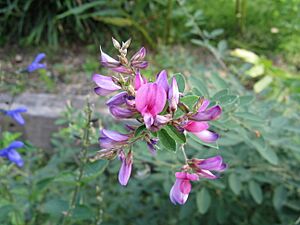Desmodium facts for kids
Quick facts for kids Desmodium |
|
|---|---|
 |
|
| Desmodium heterocarpon | |
| Scientific classification | |
| Kingdom: | |
| (unranked): | |
| (unranked): | |
| (unranked): | |
| Order: | |
| Family: | |
| Subfamily: | |
| Tribe: |
Desmodieae
|
| Subtribe: |
Desmodiinae
|
| Genus: |
Desmodium
Desv.
|
| Species | |
|
Many, see text |
|
| Synonyms | |
|
|
Desmodium is a group of flowering plants, also known as tick-trefoil, tick clover, hitch hikers, or beggar lice. These plants belong to the Fabaceae family, which is the pea or bean family. There are many different kinds, or species, of Desmodium.
Most Desmodium plants are not very showy. They usually have small flowers. They can be small herbs (like soft plants) or small shrubs (like small bushes). Their seeds are special because they are covered in tiny hooks. These hooks make the seeds stick easily to clothes, fur, or anything that brushes past them. This is why they are called "hitch hikers" or "beggar lice"! Because they stick so well, some Desmodium species can spread easily and are sometimes seen as weeds. But they also have many useful purposes.
Contents
How Desmodium Plants Are Used
Desmodium plants are very helpful in farming. They release special natural chemicals from their roots and leaves. These chemicals can keep harmful insects away from crops. For example, farmers plant Desmodium heterocarpon, Desmodium intortum, and Desmodium uncinatum between rows of maize (corn) and sorghum. This helps to repel a type of moth called Chilo partellus, which eats the plant stems.
These chemicals also stop harmful weeds, like witchweeds, from growing. This smart farming method is called "push-pull technology." The Desmodium "pushes" pests away and "pulls" them to other plants, protecting the main crops.
Helping the Soil
Tick-trefoils are also great for improving soil. They can act as a "living mulch," which means they cover the soil and protect it. They are also used as "green manure." This is because they can take nitrogen from the air and put it into the soil. Nitrogen is a very important nutrient that helps other plants grow strong and healthy.
Food for Animals
Many animals like to eat Desmodium plants. They are good fodder (food) for animals such as bobwhite quail, turkeys, grouse, deer, cattle, and goats.
Insects and Animals That Rely on Desmodium
Some insect caterpillars, like those of the lesser grass blue butterfly and the two-barred flasher butterfly, eat tick-trefoils. Deer also depend on some Desmodium species for food, especially during tough summer months when other food might be scarce.
Understanding Desmodium Species
Scientists study how different Desmodium species are related and how to name them correctly. This field is called taxonomy. It can be a bit tricky because some plants that used to be called Desmodium are now placed in other groups, like Codariocalyx or Hylodesmum.
Sometimes, different scientists might use the same name for different plants, or different names for the same plant! This can make it confusing to figure out which specific Desmodium plant is being talked about.
Some Examples of Desmodium Species
Here are a few examples of the many Desmodium species:
- Desmodium canadense – known as showy tick-trefoil or Canadian tick-trefoil.
- Desmodium canescens – called hoary tick-trefoil.
- Desmodium heterocarpon – known as Asian tick-trefoil.
- Desmodium illinoense – called Illinois tick-trefoil.
- Desmodium incanum – known as creeping beggarweed or Kaimi clover.
- Desmodium intortum – called Greenleaf desmodium or kuru vine.
- Desmodium paniculatum – known as panicled tick-trefoil.
- Desmodium rotundifolium – called round-leaved tick-trefoil or dollar leaf.
- Desmodium triflorum
- Desmodium uncinatum – known as silver-leaved tick-trefoil.
Plants That Used to Be Called Desmodium
Some plants that were once thought to be part of the Desmodium group have since been moved to other plant groups by scientists. For example:
- Codariocalyx motorius – This plant is famous for its leaves that move, sometimes called the telegraph plant. It used to be known as D. gyrans.
- Hylodesmum laxum – This plant was once called D. laxum.
- Lespedeza thunbergii – This plant was previously known as D. formosum or D. thunbergii.
See also
 In Spanish: Desmodium para niños
In Spanish: Desmodium para niños






